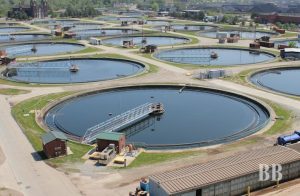Rotor Electric of Michigan, LLC was awarded Great Lakes Water Authority???s (GLWA???s) contract PC-757 for Rehabilitation of Clarifier Facilities at the Detroit Wastewater Treatment Plant (WWTP). The multi-million dollar three-package award includes:
- Package A.?? Rehabilitation of rectangular primary clarifiers
- Package B.?? Rehabilitation of electrical/mechanical buildings and pipe gallery of the rectangular primary clarifiers
- Package C.?? Replacement of rake arm assembly for circular primary clarifiers nos. 15 and 16
Project Scope
The work includes installing ventilation and atmospheric control for the pipe gallery and providing new regular and emergency lights. Rotor is also providing rehabilitation of 12 drain lines from rectangular clarifiers 1-12 and circular clarifiers 15 and 16. Additionally, we are replacing all of the sludge collector drives, sludge pumps, and sump pumps within the rectangular clarifier facility. The center drives with over one???million pound???feet of torque in the circular clarifiers are also being replaced with sump pumps to collect drainage and discharge to the clarifiers. Also included is rehabilitation work in the Electrical/Mechanical Building.
Clarifier Function
Clarifiers are extremely important pieces of equipment for processing wastewater. Primary clarifiers use gravity to allow floating and settleable solids to sink to the bottom of the tanks and be swept away. Secondary clarifiers work in a similar way to remove biological growth in the tanks.
There are circular clarifier tanks and rectangular ones. In larger waste water treatment plants, there are oftentimes more rectangular clarifiers than circular ones. Land availability and construction/operating costs are major considerations for water treatment plants. Rectangular tanks make more efficient use of space and layout.
- Rectangular clarifiers provide a longer path for the wastewater and suspended solids to travel, resulting in more sludge settling compared to circular clarifiers.
- Flow distribution among several clarifiers is usually more even and often requires less head loss for rectangular clarifiers.
- Rectangular clarifiers typically require less land than circular clarifiers for a similar surface area (21% less in theory). In a multiple-unit design, where common concrete walls are used between rectangular basins this is even more pronounced.
- The even flow of rectangular clarifiers requires simpler and less expensive pipe work layout and pumping requirements. With circular clarifiers the pipes require a more complicated layout pattern.
Meeting EPA Requirements
One of GLWA???s key objectives for this project is meeting National Pollutant Discharge Elimination System (NPDES) permit and NEC requirements. Both programs work to control the discharge of pollutants into surface waters by imposing effluent limitations to protect the environment.


